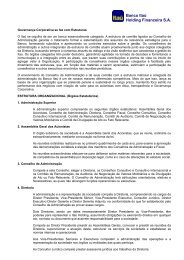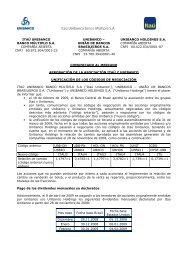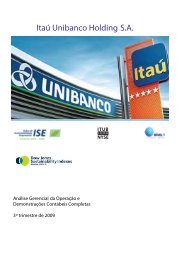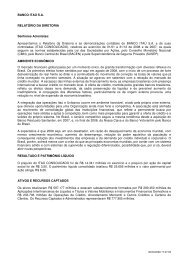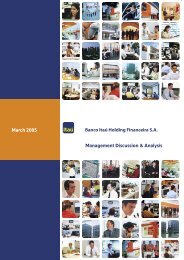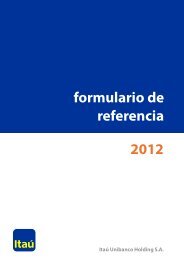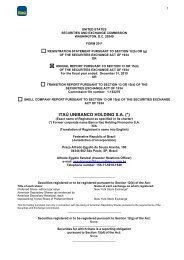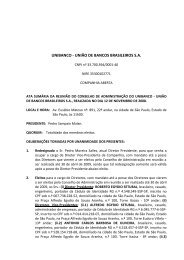ITAÚ UNIBANCO S.A. MANAGEMENT REPORT To our ... - Banco Itaú
ITAÚ UNIBANCO S.A. MANAGEMENT REPORT To our ... - Banco Itaú
ITAÚ UNIBANCO S.A. MANAGEMENT REPORT To our ... - Banco Itaú
Create successful ePaper yourself
Turn your PDF publications into a flip-book with our unique Google optimized e-Paper software.
Provision for events incurred but not reported (IBNR) – recognized for the estimated amount of<br />
events occurred but not reported;<br />
Provision for financial surplus – recognized by the difference between the contributions adjusted<br />
daily by the Investment Portfolio and the funds guaranteeing them, according to the plan’s<br />
regulation;<br />
II.III- Capitalization:<br />
Mathematical provision for redemptions – represents capitalization certificates received to be<br />
redeemed;<br />
Provision for raffle contingencies – recognized according to the methodology provided for in the<br />
Technical Actuarial Note to cover the Provision for raffles in the event of insufficient funds.<br />
o) Contingent assets and liabilities and legal liabilities – tax and social security - assessed, recognized<br />
and disclosed according to the provisions set forth in CMN Resolution No. 3,823 of December 16, 2009.<br />
I – Contingent assets and liabilities<br />
Refer to potential rights and obligations arising from past events, the occurrence of which is dependent<br />
upon future events.<br />
Contingent assets: not recognized, except upon evidence ensuring a high reliability level of realization,<br />
usually represented by claims awarded a final and unappealable judgment and confirmation of the<br />
recoverability of the claim through receipt of amounts or offset against another liability.<br />
Contingent liabilities: basically arise from administrative proceedings and lawsuits, inherent in the<br />
normal c<strong>our</strong>se of business, filed by third parties, former employees and governmental bodies, in<br />
connection with civil, labor, tax and social security lawsuits and other risks. These contingencies are<br />
calculated based on conservative practices, being usually recorded based on the opinion of legal<br />
advisors and considering the probability that financial res<strong>our</strong>ces shall be required for settling the<br />
obligation, the amount of which may be estimated with sufficient certainty. Contingencies are classified<br />
either as probable, for which provisions are recognized; possible, which are disclosed but not<br />
recognized; and remote, for which recognition or disclosure are not required. Any contingent amounts<br />
are measured through the use of models and criteria which allow their adequate measurement, in spite<br />
of the uncertainty of their term and amounts.<br />
Escrow deposits are restated in accordance with the current legislation.<br />
Contingencies guaranteed by indemnity clauses in privatization processes and with liquidity are only<br />
recognized upon judicial notification with simultaneous recognition of receivables, without any effect on<br />
results.



